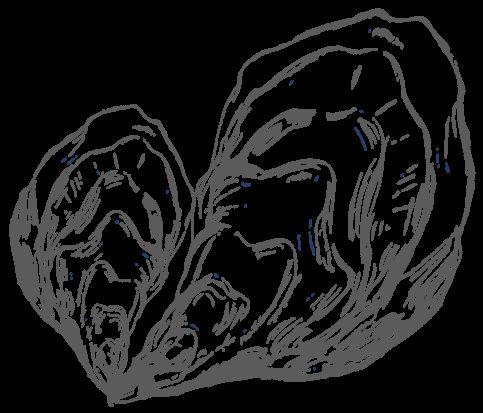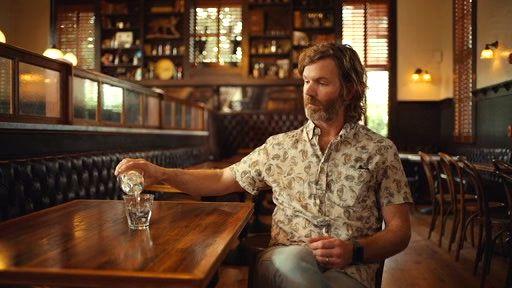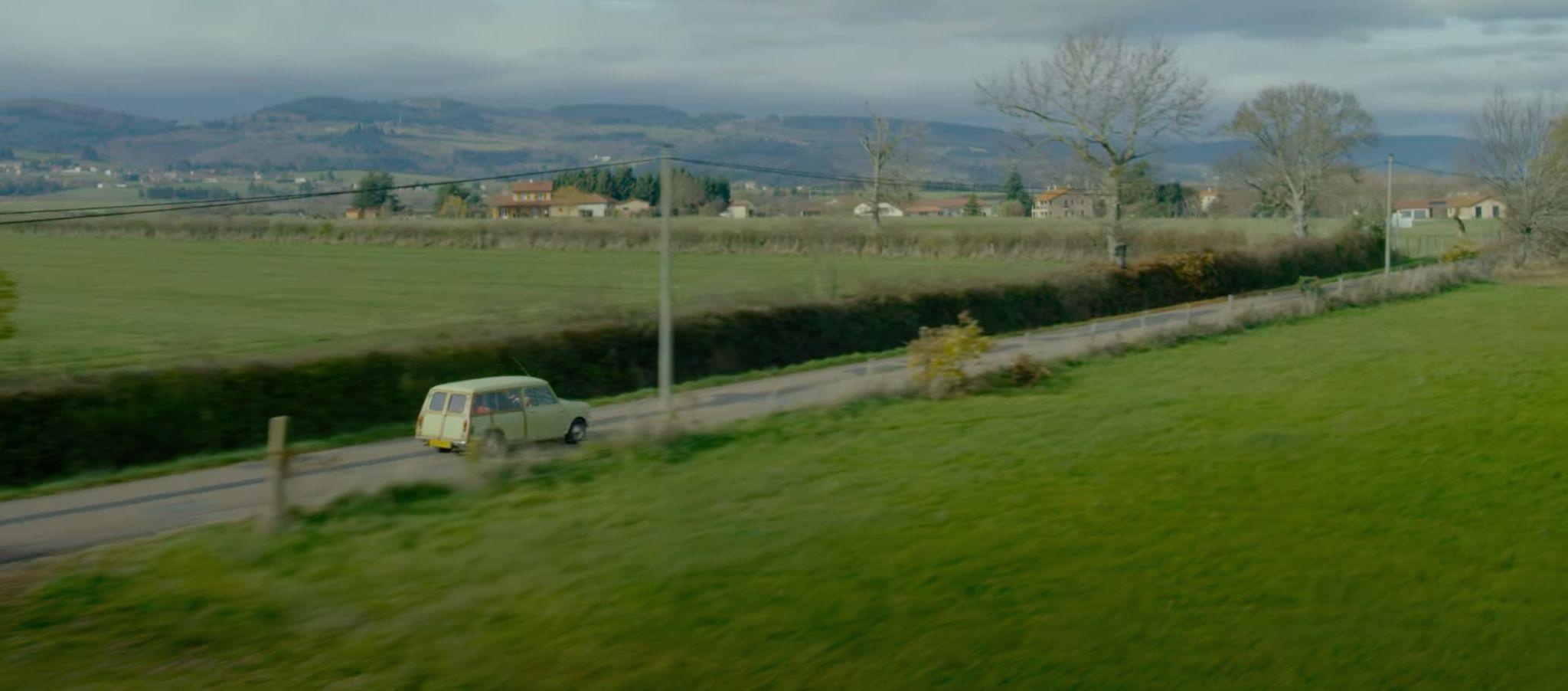The Story AnOverview
Parking an oyster front and center is like holding up a mirror to humankind. These primordial, complex, briny little organisms—best eaten alive, and damn good with a beer—have captured the hearts, minds, and palettes of humans in ways that do not compare to other foods.
Why do oysters appeal so overwhelmingly to our senses? Like great wine, why do their tastes and aromas ignite such vivid mental images and memories? There must be something there––something yoked to our nervous systems––ever since the first of us prised one open, threw it back,andrealizedthat“Damn,thesethingsaretasty.”
Ever since then, civilizations erected cities around their massive reefs, New World explorers ran their ships aground on their impenetrable beds, and cuisinières far and wide crafted dishes to the pleasure of bon vivants and gourmands. To this day there’s a near-cultish following of scientists, writers, chefs, and enthusiasts who farm, harvest, cook, think about, write about, study—and yes—devour plates of them to their heart'sdelight.Why?Whyareoystersthemostcelebratedofseafoods?
The film sets out to answer that question: to explore the captivating biology, delicious history, and cultural significance of this remarkable seafood. Unifying a cohort of James Beard Award-winning chefs, connoisseurs, leading marine biologists, and the oyster farmers who are changing the game and rewriting the future of sustainable aquaculture.
OYSTERS — THE CURIOUS STORY OF THE WORLD’S MOST CELEBRATED SEAFOOD
is the journey to the heart of a shell via science, history and the senses. By the end, you will understand our enduring obsession with this most unassuming, marvelous and misunderstoodcreaturefromthesea.
Oysters by design, are an organism that keeps the good stuff secret. However, this convivial journey into their watertight shells satisfies every appetite. Witty, engaging and well-informed. A film that is desperate to share its delights with you. In the end, you wonder at how much we know about oysters. Of course, that’s the point, because the filmismoreofaninsightintohumannaturethantheoysteritself.
OYSTERS
The Curious Story of the World’s Most Celebrated Seafood

The Story
ACTI:History&Culture
The oyster has been a part of our entire existence. There’s a cave in South Africa where scientists discovered scant remains of a shellfish dinner dating back 164,000 years. Millenia later, humans still find ingeniouswaystocultivate,prepare,andfantasizeover thesesturdymolluscsinwhatfoodwritersrefertoasan “oyster Renaissance”—though some would simply call it a mania. Food writers and oyster somms—like ROWAN JACOBSEN and JULIE QIU—will argue that our mania foroystersislong-standing,andabouttoblow.
Ever since our cave-dwelling days, oysters have played their role as a staple food source for coastal civilizations since the beginnings of recorded history. EarlyincantationsoftheAssyriansin1000BCEspeakof them. In 60 BCE, Romans perfected earlier Greek attemptsatcapturingandcultivatingwildoysterspawn in the licentious port town of Baiae—infamous for its vice;belovedforitsbeachsidetogaparties.
But of course, it was the French who thrust the mollusc into the modern age. A country, where attention to the oyster is exacting. Requiring the finest measurement of complementary food and drink,drawingourattentiontosomesomeoftheoysterworld’s
The great seafaring nations of Britain, Spain, and Portugal enjoyed a sophisticatedoysterculture.InSouthAmerica,theyweredeemedsacred. mostimprobablecharacters,includingtheostréiculteur, FRANÇOIS DE SOLMINIHAC, whose great-grandfather perfected the art and science of modern oyster farming along the Bélon River in Brittany, France with a royal charterfromNapoleonIII.
From the Greeks and Romans, to the founding of the American colonies, to the oyster bar cultures of New York City, Paris, and New Orleans, the film is a playful and comprehensive anecdote showing how oysters have been cherished and consumed throughouthumanhistory.
OYSTERS
The Curious Story of the World’s Most Celebrated Seafood
The Story ACTII:Culinary&Farming
Shifting now from history and culture to tide and table, with a keen focus on the relationship between farmer and chef. Oysters were one of the first recognized superfoods. Perhaps why early humans settled along coastlines. They found in oysters a nutrient-dense source of protein that didn’t run away. Nothing in natural history has reproduced itspotential.Notevenriceorwheat.
Moreover, no other seafood inspires as much gaiety and celebration as oysters. Ostreophiles who meet in homage, with a curious insistence on tastingeveryvariety,categorizetheirtasteandmerroirlikewine.
Through interviews with chefs and restaurant owners such as BRYAN RACKLEY from Kimball House in Atlanta, the film showcases the resurgence of oyster mania in the US and beyond, largely fueled by the growthofoysterfarming.
Oyster farming is vastly misunderstood by the general public, and its benefits are a central tenet of the film. Oysters are a keystone species, and the forward-thinking, “more good than harm” approach to farming themwillintrigueandexcitecitizenscientistsofallages.

OYSTERS
The Curious Story of the World’s Most Celebrated Seafood
The Story
ACTIII:Biology&Environment
We then take a journey inside the organism itself, delving into oyster biology. Revelations by our scientists, decipher what’s really going on. Turns out, you don’t do serious oyster research by simply eating them––althoughit’scertainlyaperkofthejob.

Oysters have attracted an abundance of marine biologists, zoologists, and even impassioned chefs who speak lucidly and in thrilling terms about their potential for farming, aquaculture, sustainability and the environment. The fossil record speaks unambiguously about them, that theywereoncepresentinenormousnumbers.
Runoff, overharvesting, and changes to the natural environment made wild oyster reefs one of the most endangered habitats in the world. Although oysters proliferated along coasts worldwide, less than 1% of America’s wild oyster reefs remain, causing environmental collapses in the once famed oyster-producing regions of Apalachicola and the ChesapeakeBaytonamejustafew.
The film becomes an exercise in imagination-stretching, with scientists like DR. BILL WALTON at the Virginia Institute of Marine Science, illuminating the intrinsic link between an oyster’s biology and its ecological benefits. Starting with the fact that a single oyster filters up to 50 gallons of seawater per day, making them a vital species for ecosystem health. With interviews from oyster farmer JODY HOUCK
from Cypress Point Oyster Company in Spring Creek, FL, we learn abouttherolethatwildoystersplayinprotectingshorelinesfromstorm surge, and the stressors that wild oysters face in our rapidly changing oceans.









1 4 7 2 5 8 3 6 9
OYSTERS
The Curious Story of the World’s Most Celebrated Seafood
Artistic Approach
This is a film about a quixotic subject with truckloads of remarkable information, delivered as delightful histories (9), mouthwatering food prep, playful illustrations and kinetic storytelling. Our artistic approach relies on a phrase that Monet shared with his pupils: Thebiggerthe vocabularyofstrokes,themoreinterestingthepaintings(1).
This mantra has captured our imaginations and freed our minds to develop a method of storytelling that conveys a sense of movement, motion, and captures all of the senses, relying on sight and sound to conveythebroadersensationsofaroma,texture,andtaste.
Ifyouweretostealaglimpseofourmoodboardforthefilm,youmight only see a mess. See chaos. But this practice allowed us to remember that filmmaking is symphonic: multiple instruments working at the same time. The central driving question that we continuously revisit throughout this project is why do oysters––and the experience of eating them––seem to shift our perspective so much? (3, 7) And why is this differentfrompersontoperson?
When it comes to food, oysters are the ultimate expression of place, creating taste-memories that are very powerful. We’re thinking about tastesthatmightnotactuallybethere,they’rejustalludedto.(8)
If our research says that the aroma of Pacific oysters is “the space betweenanappleandtheknifethatswiftlycutsit,”tocreatethattaste for audiences, our job is to amplify that through sight and sound alone. Illustrating not just a Pacific oyster on a dish, but the shine of the knife and the crisp of the apple too (2). This artistic approach heightens participation in the viewer, and allows us to project the other senses of smell,taste,andtouch.
The documentary is a tapestry of photography, paintings, readings from historical sources (5), all deftly weaving together psychology, neurology, nutrition, even philosophy - to render insights that are profound,excitingandalwayswitty.
TheAquacultureGenetics&BreedingTechnologyCenterattheVirginia Institute of Marine Science gives the filmmaking team a unique opportunity to film oysters at various stages of their lifecycle in controlled lighting environments (6). This facility allows our filmmakers to capture timelapses of oyster growth, microscopic marine life, and reproductive processes coaxed into effect only under very specific conditions. Conditions that would be near impossible to achieve in the wild.
OYSTERS
The Curious Story of the World’s Most Celebrated Seafood
“There’s something primal about eating oysters. Like sushi, oysters are best eaten raw, when the living chi has not yet fled. They have a life force in them that leaves you feeling flushed. And you will pay what it takes to get that feeling. That’s why oysters can cause people to part from their economic senses in a way generally reserved for drugs and sex. They’ll make you feel like the coolest alpha predator in the ecosystem.”
–RowanJacobsen
You can access the teaser video at: https://vimeo.com/855903290

OYSTERS
The Curious Story of the World’s Most Celebrated Seafood
The Participants
Julia Sullivan, Ryan Prewitt, and Bryan Rackley: a collection of executive chefs and restaurateurs in Nashville, New Orleans, and Atlanta,thatsomeonemightcolloquiallyrefertoasthe“BivalveBunch.”
All three committed board members of Oyster South, their efforts represent the wave of newly adopted tide-to-table oyster programs in the US, leading to exciting dishes that feature oysters all across the region.Rackley is the owner of Kimball House in Atlanta, a restaurant that specializes in oysters and cocktails among other things. Rackley is also the oyster bar manager, and his interest in oysters led to co-founding Oyster South, an advocacy nonprofit focused on southern oyster farming practices and developing the community and industry througheducation.
Julie Qiu (unconfirmed): International oyster expert, educator, and creator of the blog In A Half Shell, an international oyster appreciation websitethatshowcasestheworld’smostexceptionaloysters,producers, destinations, and enthusiasts. A self-made Oyster Sommelier, Julie has been featured by Vogue, Food & Wine, The Chicago Tribune, USA Today, NPR, Huffington Post, Tech Insider, SOMM TV, and Somebody Feed Phil on Netflix. She is co-creator of the Oyster Master Guild, a networkof
skilled oyster shuckers, sommeliers and experts committed to elevating theoysterexperienceforcustomersthroughknowledgeandguidance.
Rowan Jacobsen (unconfirmed): American author and journalist who writes about food, the environment and the connection between the two. Witty and robustly researched, his writings on oysters and the people who obsess over them are modern hallmarks of the subject matter. His two books that focus on oysters are TheEssentialOyster and A Geography of Oysters. Jacobsen’s interview acts as the glue between the other contributors (oyster farmers, marine biologists, and chefs), making connections between the history, culture, and biology of oysters. This unique perspective provides a dimensionality and relatabilitytothesubjectmatter.
François de Solminihac (unconfirmed): Huîtrières du Château de Bélon is a fifth generation oyster farm with roots in oyster farming that date back to the 1860s, when Auguste de Solminihac along with Hippolyte de Maduit and Victor Coste perfected modern oyster farming with a royal charter from Napoleon III. François de Solminihac is a fifth generation oyster farmer who still runs this ancestral oyster farm along the Bélon RiverinBrittany.
OYSTERS

The Curious Story of the World’s Most Celebrated Seafood
The Participants
Cypress Point Oyster Company: Jody and Dewey Houck, of Cypress Point Oyster Company, are breathing life back into the dilapidated fishing village of Spring Creek, FL. On top of their lofty goal of creating the Gulf’s first cocktail oyster, they have their sights set on opening a cultural center and raw bar in the small “one stop-sign town.” Now retired from careers in tech and engineering, they’re taking novel approaches to growing oysters including artificial intelligence and machine learning. Working in collaboration with CPOC, is a host of supporting characters including Cainnon Gregg, the self-proclaimed “bad boy of bivalves” and the animated force behind Pelican Oyster Company, and Adrian Morris who is starting his own oyster lease under theguidanceandsupportofJodyandDewey.
Bill Walton (aka Dr. Oyster): the Acuff Professor of Marine Science and Shellfish Aquaculture Program Coordinator at the Virginia Institute of Marine Science. Dr. Walton’s research in shellfish aquaculture takes him to oyster farms and labs across the globe. He’s great at distilling complextopicsforageneralaudience.
Jim Gossen: Bon vivant, gourmand, and founding board member of Oyster South. The oldest of seven children, which means that his mother needed to cook with economy. One-pot meals, Jim calls them. A single hen could feed everyone, for example, as long as it was made into a gumbo. After a long career in restaurants, Jim entered the wholesale seafood business. These days you won’t find him toiling behind a restaurant stove, but he’s likely to greet you with a pan of baked oysters, a slice of root beer-glazed ham, or hot biscuits brushed with meltedbutter.
OYSTERS
The Curious Story of the World’s Most Celebrated Seafood Director’s Bio
Bud Simpson is an international director / DP known for his documentaries and brand films. His work has been featured in the BBC docu-series StoryWorks and in film festivals internationally including Big Sky Documentary Film Festival, Newport Beach,SidewalkFilmFestival,Cucalorus,Oxford,andOaxacaFilmFestivals.
In the commercial world, Bud has shot for brands such as Mercedes Benz, Americorps,ClifBar,StellaArtois,IHGHotels,andKodak. Forafulllistofworks,pleasevisitwww.budsimpson.com.

OYSTERS
The Curious Story of the World’s Most Celebrated Seafood Filmmaker’s Statement
Let’stalkaboutoysters,andwhytheuniverseispullingonmyheartand mind to make this film. OYSTERS is a story that fires on all cylinders for me. Erudite, provocative, idiosyncratic, this film offers an unflinching polemicaboutabivalve.Fromthefirstminute,everythingaboutoysters suddenly becomes fascinating and this playful documentary tale offers real-worldanswersto––notall––butsomeofthefoodandenvironmental challenges we face today. When I tell people this, they tend to cock their heads. “Why so passionate about oysters?,” they ask. It wasn’t always like this, but I remember when I started falling down and down, intothisbrinyshellofastory.
It was a cool fall day in 2019, when a friend of mine from high school took me out to his oyster lease just south of Tallahassee, FL in Alligator Harbor––not far from where I grew up. It was my first time seeing an oyster lease: a collection of floating cages peppered across the harbor’s north shore, strung out on a long anchored line. There, nestled between a sandbar and sunken diesel engine was a two-man oyster farm of 1200 cages on 1.5 sub-tidal acres. Their livelihood depended on nurturing fledgling oysters (or spat, as they’re called) from infancy to adulthood, andgod-willingtomarket.
Immediately, I felt that twinge––that little voice that said “There’s something more to this. You should dig deeper.” The dynamics, the contours, the interiors of oyster farming and this way of life had something that was drawing me in. That was almost four years ago now. Ever since, I have fallen––like many others––for the allure of oysters.
I look forward to exploring this new part of the world. I hope that our words have given you that same twinge I had in Alligator Harbor four yearsagoandthatyouarecurioustolearnmore.Lastly,Ihopethatwe have shown you our eagerness to teach, and have demonstrated our ability, knowledge, skill and dedication to execute on this most thrilling of undertakings, and to transform your participation into a meaningful story that will delight and inform citizen scientists, foodies, and bon vivantsofallages.
Cheers, Bud
OYSTERS
The Curious Story of the World’s Most Celebrated Seafood
Project Timeline
March 2023
August 2022
Initial due diligence
October 2022 - February 2023
Development filming
Onboard phase II investors and distribution partners
March 2023 - March 2024 Production
March 2024 - August 2024
Post-production
August 2024
Distribution begins
Shoot #1 Wakulla County, FL
Shoot #2 Wakulla County, FL
Application Sundance Institute
Documentary Film Program
Shoot #3 New Orleans, LA
Shoot #4 Savannah. GA Phase II Prep Finalize fundraising sample; secure character agreements
OYSTERS
The Curious Story of the World’s Most Celebrated Seafood






















